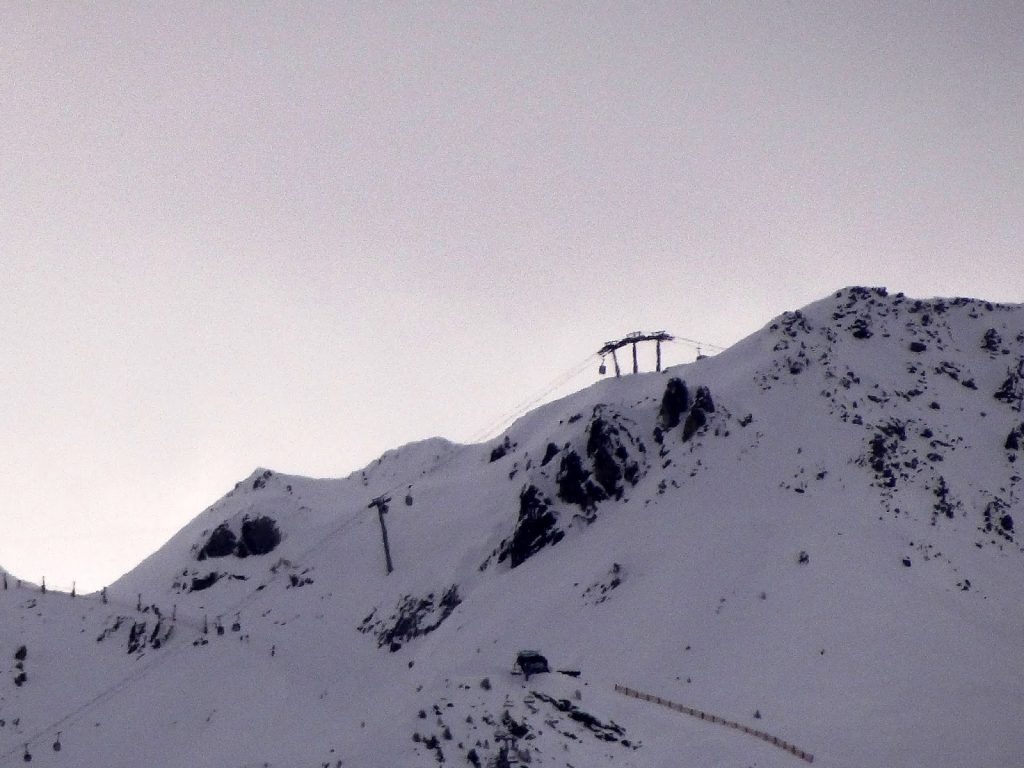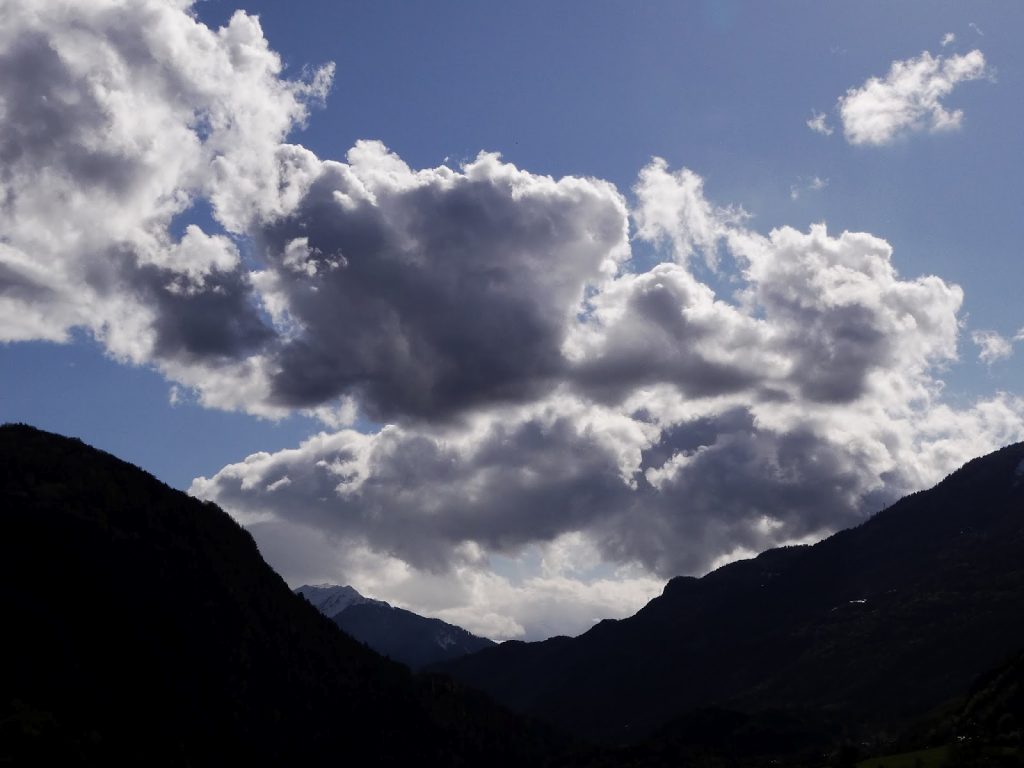the “Most Impressive Award” – but only by the end of the blog. David has been unashamedly fishing for it and is the
strongest skier but nothing is guaranteed. Thomas is only 16 but already 6ft
5ins (even without his Adidas Rose 1.5 ankle snapping basketball shoes) and that’s already quite impressive (1) but perhaps slightly irrelevant.
Melanie is quiet but busily working away hard in the background – possibly the
dark horse! The person who scores the highest number of “impressives” wins.
off today had been to introduce ChiSkiing to Melanie and Thomas. In Melanie’s
case it would be to work against her rotation. In Thomas’s case it would be to
try to raise his body awareness and help address postural issues that were both
blocking him and threatening potential damage to his lower back. David had missed all of
yesterday so he wasn’t part of this plan and it wasn’t at all what I’d have
chosen to work on with him at this point – but it would still serve to highlight certain issues quite effectively.
Sideslip
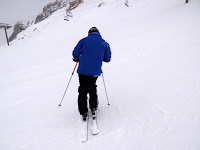 David skis with the classic “face the body downhill and feet together” stance – which should in general keep the hip in the correct place. Proof that this really doesn’t do the job or lead to any proper understanding can be seen in the photo of David sideslipping. Regardless of the positioning of his shoulders the pelvis is twisted in the wrong direction and instead of showing “angulation” (angle between the legs and upper body when viewed in the direction of the skis) we see an inverse angulation – or in plain speak – his bum is pointing downhill and it should be pointing uphill. This is even more significant in the context that he is actually trying to point his bum uphill and is unaware of what is happening instead. Yes this is an impressive (1) lack of awareness – but otherwise quite normal.
David skis with the classic “face the body downhill and feet together” stance – which should in general keep the hip in the correct place. Proof that this really doesn’t do the job or lead to any proper understanding can be seen in the photo of David sideslipping. Regardless of the positioning of his shoulders the pelvis is twisted in the wrong direction and instead of showing “angulation” (angle between the legs and upper body when viewed in the direction of the skis) we see an inverse angulation – or in plain speak – his bum is pointing downhill and it should be pointing uphill. This is even more significant in the context that he is actually trying to point his bum uphill and is unaware of what is happening instead. Yes this is an impressive (1) lack of awareness – but otherwise quite normal.
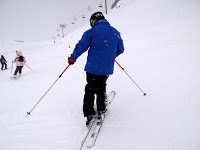 Thomas was still struggling with sideslip and was running off forwards all the time. He blamed his skis! This is a most impressive (2) cop out! When your legs are locked up with tension then the skis will appear to have a life of their own. When Thomas declared (later) “It’s not me!” I pointed out that there was no one else in his ski boots so it must be him. At some point in the day we did the “arm curl” exercise – where we pretend to have a dumb bell in the hand and do arm curls. This exercise teaches us about “resistance” – when we fight against ourselves. When the arm is straightened and all the muscles in the arm clenched it becomes impossible to do any arm curls. This is similar to what Thomas (or somebody else) is managing to do with his legs – but unconsciously. Perhaps this is an early warning of schizophrenia, or perhaps in a very real way somebody else – your unconscious – is in charge of the body! Thomas didn’t mean any of that though – he was trying desperately to blame his skis.
Thomas was still struggling with sideslip and was running off forwards all the time. He blamed his skis! This is a most impressive (2) cop out! When your legs are locked up with tension then the skis will appear to have a life of their own. When Thomas declared (later) “It’s not me!” I pointed out that there was no one else in his ski boots so it must be him. At some point in the day we did the “arm curl” exercise – where we pretend to have a dumb bell in the hand and do arm curls. This exercise teaches us about “resistance” – when we fight against ourselves. When the arm is straightened and all the muscles in the arm clenched it becomes impossible to do any arm curls. This is similar to what Thomas (or somebody else) is managing to do with his legs – but unconsciously. Perhaps this is an early warning of schizophrenia, or perhaps in a very real way somebody else – your unconscious – is in charge of the body! Thomas didn’t mean any of that though – he was trying desperately to blame his skis.
Simplifying Chips (Photo – Les Arcs taken from Aime 20th April)
It is always important to be able to simplify coordination – but without becoming simplistic. I pointed out that the best way to deal with this is to remember that skiing uses one leg at a time and that everything applies to the one leg being used for support: Roll the foot inwards, Touch the shin on the boot, Pull inwards with the adductors, Pull the hip back (but NOT the shoulders) – from the beginning to the end of the turn. Melanie skied without any noticeable rotation but I was aware that she had also done that yesterday on the same easy terrain so there was no guarantee of any real change just yet. When David pulled his hip back it only made his “face downhill and feet together, push out both heels” even worse. It was actually an impressive (2) demonstration of this major fault – which is a pure product of traditional ski school teaching.
Dynamics Digression
Trying to get David to avoid the “heel pushing” I asked him to ski with his feet slightly further apart and to use dynamics – moving the Centre of Mass instead of his feet. David’s (or a least his unconscious mind) determination to remain facing downhill at all cost was impressive (3). This led to some very strange looking contortions when trying to implement dynamics. I really wanted to help but it would have meant digressing the lesson totally off in other directions so I kept feedback to a minimum and just advised David to let the body follow the skis for the time being so as to keep the dynamics movements simple and lateral to the direction of travel (and hence to the upper body).
Posture (Photo – Meribel taken from Aime 20th April)
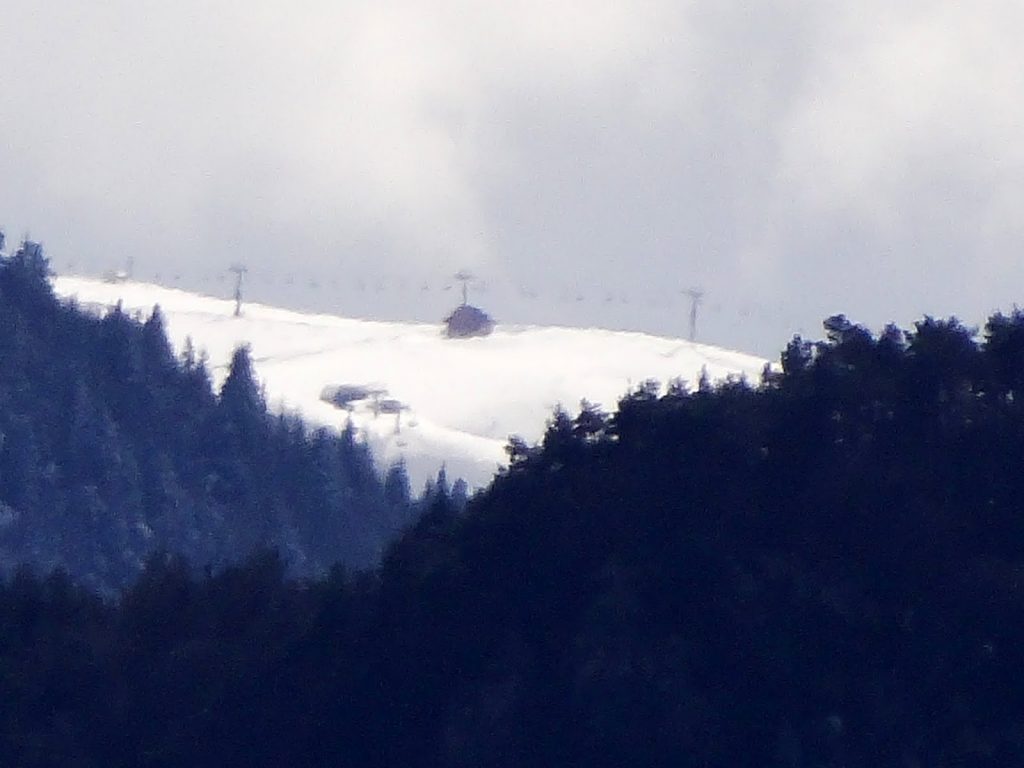 Part of Thomas’s current difficulty was affecting his posture and I’d wanted to use ChiSkiing to help with that. Now that the basic movement pattern was understood it was time to look at Thomas’s postural issues. We established roughly where the hip joint was hidden beneath his jacket and I asked him to bend at the hip. Naturally he responded by impressively (3) bending every joint in his spine and keeping the hip relatively stiff. Once this was sorted out I asked Thomas to keep his back straight and to contract his lower abdomen – between the pelvis and the navel – so as to generate a slight pelvic tilt (upwards at the front). When only the lower abdomen are involved then this can be done without risking flattening or rounding the whole lower back and also this prevents the back from being hollowed – all of which can be dangerous. We are basically looking for a “neutral pelvis” but in a dynamic situation. Relaxing the hip and “crunching ” the lower abdomen should generally automatically look after the posture. Until now David had been alternating from having a rounded lumbar spine to a hollow one – with no control over the issue. The majority of the time the back was rounded due tho the hip being locked up. This was caused by stemming the uphill ski outwards – pushing the leg away – then bracing against the leg and locking up all the muscles in a constant battle. With he hip locked the back was bending and taking the strain instead. We didn’t have a lot of time to spend on this but I had just wanted to get Thomas started with thinking about all of this. It was clear that no matter how hard he tried he could not hold his support leg beneath him with the knee slightly inwards (due to adduction – not twisting) and the tension was seriously affecting his skiing, posture and ability to progress.
Part of Thomas’s current difficulty was affecting his posture and I’d wanted to use ChiSkiing to help with that. Now that the basic movement pattern was understood it was time to look at Thomas’s postural issues. We established roughly where the hip joint was hidden beneath his jacket and I asked him to bend at the hip. Naturally he responded by impressively (3) bending every joint in his spine and keeping the hip relatively stiff. Once this was sorted out I asked Thomas to keep his back straight and to contract his lower abdomen – between the pelvis and the navel – so as to generate a slight pelvic tilt (upwards at the front). When only the lower abdomen are involved then this can be done without risking flattening or rounding the whole lower back and also this prevents the back from being hollowed – all of which can be dangerous. We are basically looking for a “neutral pelvis” but in a dynamic situation. Relaxing the hip and “crunching ” the lower abdomen should generally automatically look after the posture. Until now David had been alternating from having a rounded lumbar spine to a hollow one – with no control over the issue. The majority of the time the back was rounded due tho the hip being locked up. This was caused by stemming the uphill ski outwards – pushing the leg away – then bracing against the leg and locking up all the muscles in a constant battle. With he hip locked the back was bending and taking the strain instead. We didn’t have a lot of time to spend on this but I had just wanted to get Thomas started with thinking about all of this. It was clear that no matter how hard he tried he could not hold his support leg beneath him with the knee slightly inwards (due to adduction – not twisting) and the tension was seriously affecting his skiing, posture and ability to progress.
So far we had established that it wasn’t actually Thomas skiing and that he was putting more energy into fighting against himself than anything else. In addition to that he was doing a good job of resisting practically everything I said.
In an attempt to break Thomas’s tension I asked him to bend very low – to almost 90° with the knee and hip joints. Thomas bent – leaning his upper body over horizontal but hardly bending his knees. This wasn’t exactly copying me. Battling through his impressive (4) mental resistance we managed to get him to do it and when he skied like this he had a lot more control over his legs – whoever they belonged to.
I got Thomas to remove his skis (earlier on) and stand on a steep slope facing downhill. From this position you can sink down into a proper “sitting” stance without falling backwards – like sitting on a chair on a steep slope. This keeps the knees and feet ahead of the body and this is necessary for skiing difficult or deep snow and moguls. This way you can appreciate how to bend the knees and hips without leaning the upperbody forwards.
David also has a postural issue sometimes which stems from bracing with his hip pushed forwards and upperbody almost leaning backwards. This is a variation on the theme demonstrated already in “sideslipping”. Unfortunately David’s attempt to correct this was leading to a very unnatural appearance that I simply didn’t have the time to even attempt to unravel. What was good though was that he was clearly experimenting and responding to feedback. He could knock off the gorilla act instantly when asked to.
Off Piste
We made a brief excursion off piste but the snow was sun crusted already and not easy to ski so we pulled straight out of it. That was unfortunate because it would have been nice for everyone to feel how easy the dynamics makes off piste when the snow is at least half descent.
Carving (Photo – La Plagne taken from Aime 20th April)
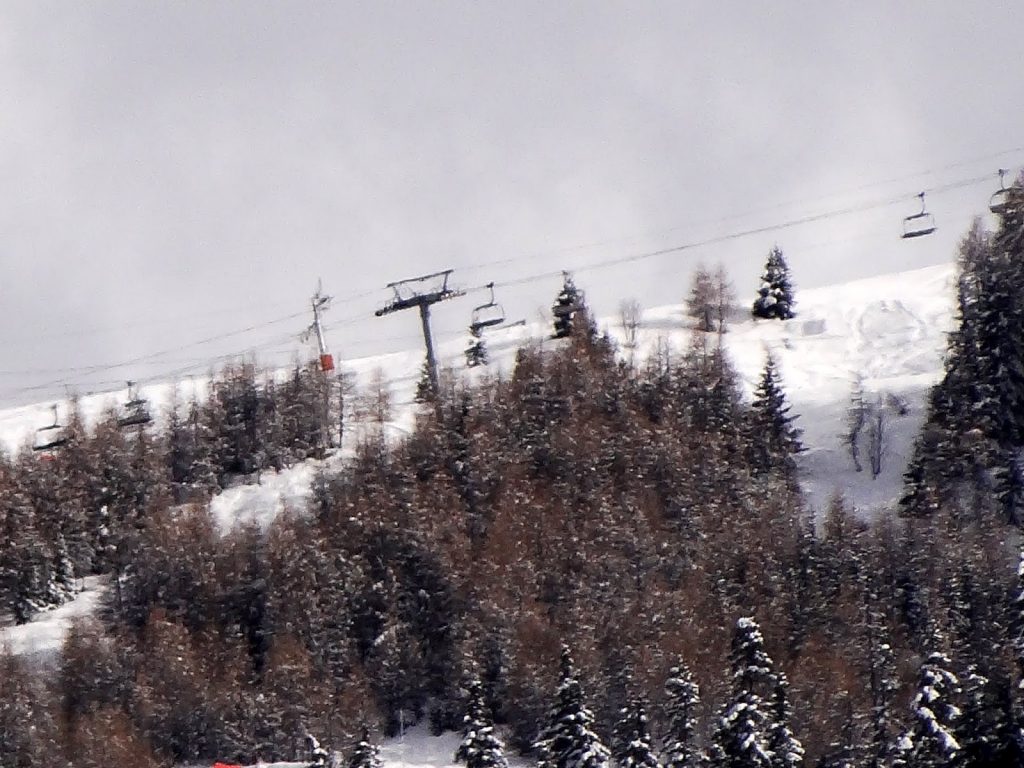 I’d deliberately gone over to the Grand Pré area to teach carving. The piste is gentle and very wide there with few people around so it’s perfect for this job. First of all we did some two edged traverses gently pointing downhill to start with and swinging back uphill – trying to ride the edges like railway lines. I pointed out that it didn’t matter where the body weight was for this exercise. We then looked at how to change edge by moving the body across the skis and not displacing the skis. This is done by standing across a gentle gradient and using the poles to hold up the body when moving over onto the downhill edges. Statically like this it’s also possible to practice and isolate all the other things that need to be done – including the ChiHips. Carving is a special case – it’s when the skis are totally locked on their edges. Anything other than this is not carving. One advantage of this for David is that to get it right it forces him to move his Centre of Mass and restrain from pushing the feet sideways. The feedback from carving is so solid and clear and sustained that even men can “feel” it! However I have encountered many who couldn’t. David fortunately is not one of them.
I’d deliberately gone over to the Grand Pré area to teach carving. The piste is gentle and very wide there with few people around so it’s perfect for this job. First of all we did some two edged traverses gently pointing downhill to start with and swinging back uphill – trying to ride the edges like railway lines. I pointed out that it didn’t matter where the body weight was for this exercise. We then looked at how to change edge by moving the body across the skis and not displacing the skis. This is done by standing across a gentle gradient and using the poles to hold up the body when moving over onto the downhill edges. Statically like this it’s also possible to practice and isolate all the other things that need to be done – including the ChiHips. Carving is a special case – it’s when the skis are totally locked on their edges. Anything other than this is not carving. One advantage of this for David is that to get it right it forces him to move his Centre of Mass and restrain from pushing the feet sideways. The feedback from carving is so solid and clear and sustained that even men can “feel” it! However I have encountered many who couldn’t. David fortunately is not one of them.
Thomas was also able to benefit a great deal from carving. His stance looked much more relaxed and that’s because he wasn’t having to deal with the skis going sideways – which pulls the knee outwards as the ski tries to flatten. This gave Thomas a chance to feel the things he had been working on a bit more clearly.
Melanie carved impressively (2) from the start – with clean edge changes, coordination and dynamics.
Speed Control (Photo – Les Arcs, Peisey Nancroix taken from Aime 20th April)
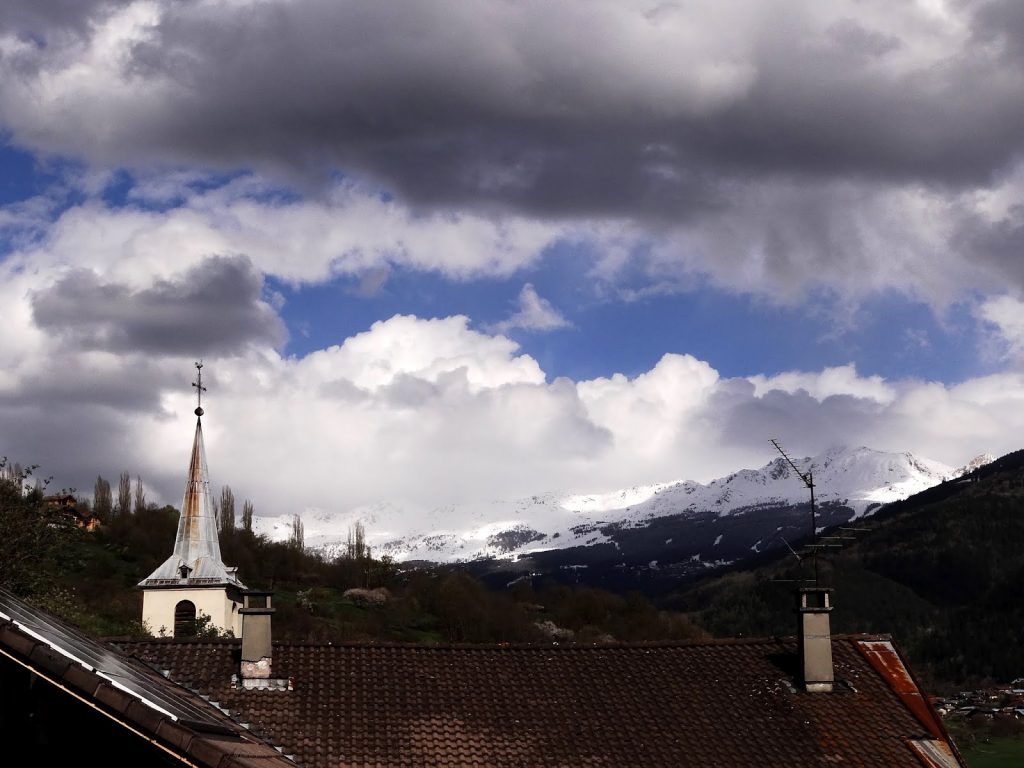 I noticed that when Melanie was left to find her own way down the mountain she rushed her turns and some rotation would creep back in. It was obvious that she wasn’t aware of how to exploit the turns correctly and this was confirmed when I brought the subject up. I explained that any turn can bring you to a complete stop and that in general control of speed comes not from braking but from exploiting the line of the turn as far round and almost back up the hill as necessary to obtain the desired speed. Speed control comes from choice of “line” not from braking. The start of the turn should be smooth and prolonged with a smooth acceleration – not a rush to throw either the body (Melanie) or feet (David) around to brake. The speed then smoothly dissipates as you come back across the hill. This is a question of tactics or strategy – not technique and Melanie had no trouble understanding it.
I noticed that when Melanie was left to find her own way down the mountain she rushed her turns and some rotation would creep back in. It was obvious that she wasn’t aware of how to exploit the turns correctly and this was confirmed when I brought the subject up. I explained that any turn can bring you to a complete stop and that in general control of speed comes not from braking but from exploiting the line of the turn as far round and almost back up the hill as necessary to obtain the desired speed. Speed control comes from choice of “line” not from braking. The start of the turn should be smooth and prolonged with a smooth acceleration – not a rush to throw either the body (Melanie) or feet (David) around to brake. The speed then smoothly dissipates as you come back across the hill. This is a question of tactics or strategy – not technique and Melanie had no trouble understanding it.
Pivoting (Photo – Valley towards Moutiers taken from Aime 20th April)
We did some work again on pivoting and David was quite good at this – which probably comes as a legacy from his “feet together stance” and his 1970s 2m long straight skis – which we both agreed should not have been thrown out. They still make straight skis for skiing in steep couloirs because only skis with very little sidecut can grip under foot when it is seriously steep. Not that I was planning on taking anyone to such a place too soon.
David didn’t need any encouragement to initiate the turns from his uphill edges – that came easily for him. Without any doubt that’s because he has done this for many years but without being specifically aware of it. Mogul skiers do this by default also so David is probably relatively comfortable in the bumps compared to the rest of the family. The main thing to work on was using pole support to feed the body towards the inside of the turn – particularly through the end of the turn where the body has to work hardest to remain uphill of the vertical. The pole is used at the start of the turn to get the Centre of Mass moving downhill without the ski changing edge. The adductors are kept taught so as to pull the skis into the turn while they are on the uphill edges. Most people then fail to fight to stay inside the turn towards the end when all the forces are conspiring together to lift them out of the turn. This was partly the reason why Melanie had been struggling with her rotation. Rotation directly brings the hips and Centre of Mass out away from the turn centre so there is no possibility of maintaining a controlled line through the completion of a turn. Working at this slowly with the controlled pivot is a way to develop awareness of where the Centre of Mass really needs to go and just how much extra work is really required to stay properly in the turn as it progresses.
Compression Turns
We made another slight deviation off piste so that I could show how to use the pivot from a very low stance. When the turn is initiated during the lowering of the stance (if the legs are under tension) it is called a compression turn. If the legs just “let go” it is called “leg retraction”. Compression simulates the sensation and effect of hitting a bump or mogul (or loading up in very deep snow) and using it to pivot on. The compression turn automatically generates the “sitting” stance that gets the knees and feet protectively ahead of the body.
Thomas or somebody resembling him and wearing his ski boots refused – like a show jumping horse stopping dead at a gate. This was another impressive (5) cop out – once again blamed on the skis. Melanie nervously baled out and put her backwards diagonal sideslip practice to good use. David the “natural” pivoter had a go at it and came through impressively (4) enough to be able to enjoy abusing the others for a while until they picked their way down.
Dynamics part 2 (Perpendicularity)
At this stage I was still worried that Melanie would get to the slush further down and it would all go pear shaped once again. There was a major aspect of dynamics that we hadn’t looked at though and sometimes this can have an astonishingly liberating effect – but not for every skier. I asked Melanie how exactly she would be standing when she completed a dynamic flowing turn. (The type of turn was deliberately chosen because it is not the same when pivoting) Melanie said “perpendicular” by which she meant “vertical” and perpendicular to the horizontal. I explained that this was wrong and that the turn was completed when the skier was “perpendicular” to the mountain and the skis flat – so the skier would not be vertical. This is the case when joining two turns. Melanie would have been correct if going only from a turn into a traverse – but we were concerned with linking turns. I demonstrated how the ski would lift me up out of the turn – like a motorbike completing a turn and then I was obliged to fall into the next turn because of already being beyond the vertical. In fact this is what makes linking turns easy and smooth. If the turns are not joined in this way then a smooth line is impossible. Slush gives a great support for lifting you up like this so when good and complete dynamics are used in and out of the turns, slush becomes very enjoyable to ski. Melanie did an impressive (3) job of putting this to use through the slush.
Body Awareness
It was clear that Melanie had an impressive (4) level of body awareness matched with an equally impressive (5) ability to focus. This is no accident because those two things go hand in glove. Awareness of the body comes from focusing on it and re-focusing on it when distracted. The mental exercise of focusing actually both relaxes and strengthens the mind – removing irrelevant or even negative internal chatter going on in the head. Using the body or breathing to focus on has the effect of grounding or centering the person through being in contact with the body. People who are neurotic or highly distracted invariably have no sense of their own body. Skiing should be practiced constantly in this manner – like a moving meditation. When done this way it is a constant development and regenerative process. Stress evaporates. Chirunning and Chiwalking have a similar effect but with even more physical benefit due to their aerobic nature. Melanie was the one who spotted the use of the glutes when we practiced Chiwalking for only a few seconds. That did impress (6) me.
Most Impressive Award (MIA)
The MIA award hereby goes to Melanie. (This is not to be confused with “Missing In Action” which is normally reserved for Chris’s ski clients! “Chaq’un à ça place”, Chris!)

